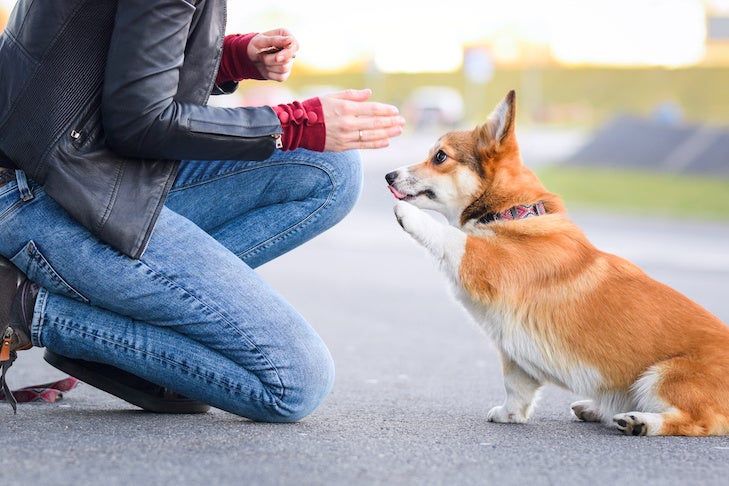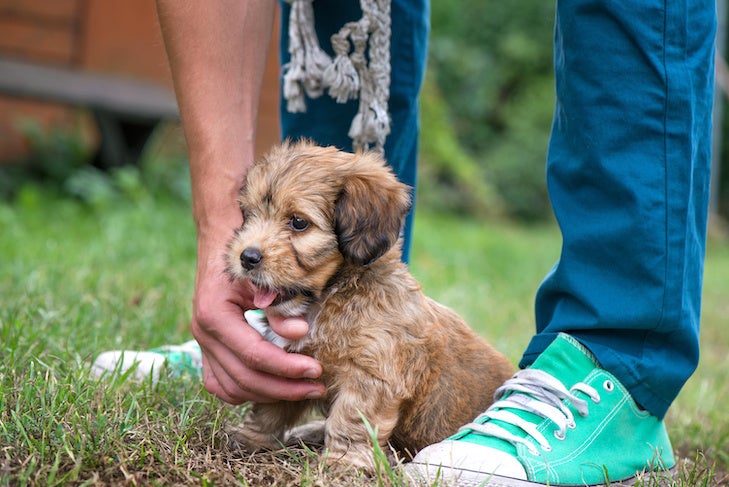
Since mid-March of 2020, social distancing has put up another hurdle in raising and training new canine family members.
At my dog training school, where we see hundreds of clients a month, it became vitally important to create new ways to make sure our four-legged students got the education they needed to become great companions.
Enter virtual classes!
I’ve had experience with online instruction for years. I’m comfortable with Facebook Live and Zoom lessons. It isn’t an odd way of teaching.
But the human students posed a challenge. They were so used to the idea of being in a classroom with a trainer, other owners, and their dogs, that they had trouble with the notion of training virtually.
Only a handful of students signed up the first week. They wanted to work on problems posed by lockdown, like “my dog jumps on my kids when they’re doing their online schoolwork,” or “my dog is barking nonstop when I’m on a work call.” Most of these problems were easily addressed online, because students could practice in the environment where the behaviors are taking place and trainers could identify exact triggers in the students’ actual homes.
After a few short weeks, our online student enrollment jumped to three digits, and we never looked back. We now have students from all across the U.S. and Canada.
Even when we’re able to open up classes at the school again, we’ll continue to offer online learning as an option.
Get Set
We learned a lot about how to make it work. The biggest reason for our success is that the trainers laid out specific “action plans” for our students so that we wouldn’t waste time teaching things that couldn’t be put into practice.
With everyone being online during the day for some reason (their job, their kid’s school), we knew that while it seemed like people staying home had loads of time on their hands, they actually had less.
We had to make sure that our students were working as efficiently as possible. A checklist helped them set up so they could get right down to work and make the most of each session. The recommendations included:
- Set up the room you’re going to work in. Get your treats, a timer, and anything else you need.
- Review your list and pick the two to three things you want to focus on.
- Take your puppy or dog out for a quick potty break.
- Go into the area and make sure no one is going to bother you.
- Turn on your timer and, if you’re going to take video, your camera.
- Start training.
- When you’re done, crate your dog and write some quick notes on how the session went so that you know what to work on next time.

When You Can’t Meet and Greet
Basic commands were something we continued to teach, but most students were most concerned about socialization. We offered some creative ways to move forward with this important aspect of canine education, even with the limitations caused by sheltering in place. Here are a few exercises:
- Say your puppy’s name and reward for even a quick glance.
- Teach that a doorbell means to run to their bed for treats.
- Use their meals in a training session.
- Move their crate, even if you just change its orientation.
- Move one piece of furniture or add new items daily.
- Create an obstacle course with boxes or other objects for your puppy to walk over.
- Play the “parking meter game” to teach your puppy to not be “grabby” about treats: Hold a treat up and slowly lower it to his mouth. If at any point the puppy or dog jumps or even reaches for it, quickly move it a few inches up, and then slowly lower it again. When the treat is even with his mouth and he looks like a “parking meter”—not moving—pop it into his mouth.
- Bathtub games: It’s important to teach puppies to love the bathtub at an early age. Get them used to the tub by feeding meals and treats in a dry tub, or just sitting and cuddling in it.
- Drive somewhere new and take your puppy out and about every day.
- Use Alexa to get your dog used to city, farm, and other sounds.
- Hide treats in an empty box, tape it up, and let the puppy find them.
Whether you’re working from home, or helping your kids with distance learning, or both, setting aside the time to train is key. Block it off in your calendar, make a plan, and do it!
Goal Posts
This plan is for my student, Mallory.
Create a sheet of weekly goals:
- Teach “sit” and “down” to Stage 2.
- Do “come when called game” every day.
- Advance “parking meter game” to Stage 3.
- Finish “body handling game 1” and move to No. 2 next week.
This ensures that you’ll be focused on progressing the training, rather than just practicing the same things week after week.
Then make a daily log that consists of two or three
sessions of 10 to 15 minutes each. Each session should include:
- Impulse-control practice, like the “parking meter game”
- Command (sit or down)
- Body-handling exercise
- Recall game
Kathy Santo trains dogs for home and competition at her New Jersey school. She is the author of Kathy Santo’s Dog Sense and has handled multiple obedience trial champions. Check out her new digital dog-training course at dogtrainingtribe.com.
Originally published in July/August 2021 issue of AKC Family Dog magazine.


